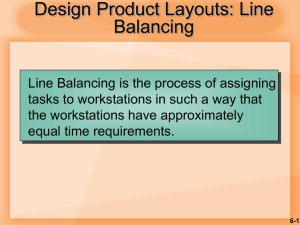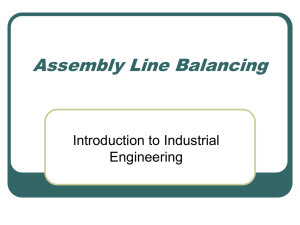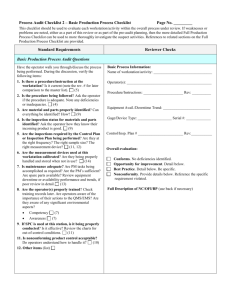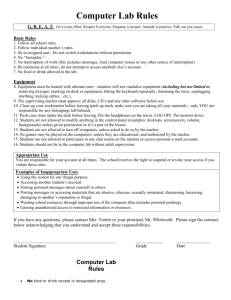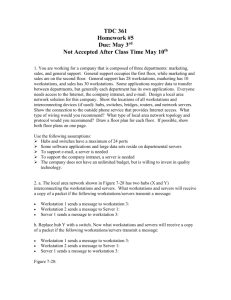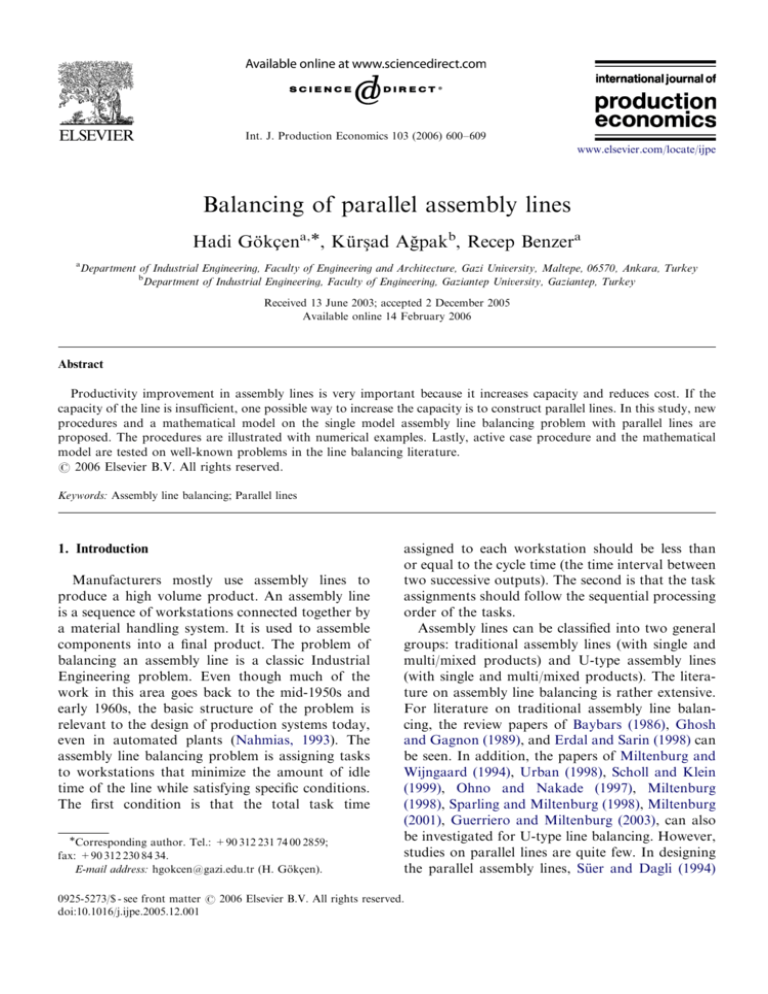
ARTICLE IN PRESS
Int. J. Production Economics 103 (2006) 600–609
www.elsevier.com/locate/ijpe
Balancing of parallel assembly lines
Hadi Gökc- ena,, Kürs-ad Ağpakb, Recep Benzera
a
Department of Industrial Engineering, Faculty of Engineering and Architecture, Gazi University, Maltepe, 06570, Ankara, Turkey
b
Department of Industrial Engineering, Faculty of Engineering, Gaziantep University, Gaziantep, Turkey
Received 13 June 2003; accepted 2 December 2005
Available online 14 February 2006
Abstract
Productivity improvement in assembly lines is very important because it increases capacity and reduces cost. If the
capacity of the line is insufficient, one possible way to increase the capacity is to construct parallel lines. In this study, new
procedures and a mathematical model on the single model assembly line balancing problem with parallel lines are
proposed. The procedures are illustrated with numerical examples. Lastly, active case procedure and the mathematical
model are tested on well-known problems in the line balancing literature.
r 2006 Elsevier B.V. All rights reserved.
Keywords: Assembly line balancing; Parallel lines
1. Introduction
Manufacturers mostly use assembly lines to
produce a high volume product. An assembly line
is a sequence of workstations connected together by
a material handling system. It is used to assemble
components into a final product. The problem of
balancing an assembly line is a classic Industrial
Engineering problem. Even though much of the
work in this area goes back to the mid-1950s and
early 1960s, the basic structure of the problem is
relevant to the design of production systems today,
even in automated plants (Nahmias, 1993). The
assembly line balancing problem is assigning tasks
to workstations that minimize the amount of idle
time of the line while satisfying specific conditions.
The first condition is that the total task time
Corresponding author. Tel.: +90 312 231 74 00 2859;
fax: +90 312 230 84 34.
E-mail address: hgokcen@gazi.edu.tr (H. Gökc- en).
assigned to each workstation should be less than
or equal to the cycle time (the time interval between
two successive outputs). The second is that the task
assignments should follow the sequential processing
order of the tasks.
Assembly lines can be classified into two general
groups: traditional assembly lines (with single and
multi/mixed products) and U-type assembly lines
(with single and multi/mixed products). The literature on assembly line balancing is rather extensive.
For literature on traditional assembly line balancing, the review papers of Baybars (1986), Ghosh
and Gagnon (1989), and Erdal and Sarin (1998) can
be seen. In addition, the papers of Miltenburg and
Wijngaard (1994), Urban (1998), Scholl and Klein
(1999), Ohno and Nakade (1997), Miltenburg
(1998), Sparling and Miltenburg (1998), Miltenburg
(2001), Guerriero and Miltenburg (2003), can also
be investigated for U-type line balancing. However,
studies on parallel lines are quite few. In designing
the parallel assembly lines, Süer and Dagli (1994)
0925-5273/$ - see front matter r 2006 Elsevier B.V. All rights reserved.
doi:10.1016/j.ijpe.2005.12.001
ARTICLE IN PRESS
H. Gökc- en et al. / Int. J. Production Economics 103 (2006) 600–609
suggested heuristic procedures and algorithms to
dynamically determine the number of lines and the
line configuration. Also, Süer (1998) studied alternative assembly line design strategies for a single
product. The objective was to determine the number
of assembly lines with minimum total manpower.
For this purpose he proposed a 3-phase methodology: assembly line balancing, determining the
parallel workstations and parallel lines. Other
researches involving parallel workstation have
focused on the simple assembly line balancing
problem (Simaria and Vilarinho, 2001), mixedmodel production line balancing problem (Askin
and Zhou, 1997; McMullen and Frazier, 1997;
Vilarinho and Simaria, 2002).
Most manufacturing plants consist of one or
more assembly lines. When the demand is high
enough, it is not uncommon to duplicate the entire
assembly line. This provides the advantage of
shortening the assembly line, but may require more
equipment and tools. Another advantage of parallel
assembly lines is seen during workstation breakdowns. If equipment problems occur at a workstation, other lines can continue to run. A single
serial line must be shutdown whenever there is a
failure at any workstation.
The approach presented here is quite different
from Süer’s (1998) approach. In this paper, the
number of lines to be parallelized is not considered
and is not important to be determined as in Süer’s
(1998) study. The goal is to balance more than one
assembly line together. That is, it will be possible to
assign task(s) from each line to a multi-skilled
operator. As a result, it is inevitable to minimize the
total idle time of the lines.
2. Notation
The following notations are used in this paper:
C
cycle time
Card{F} cardinality of set F, i.e. number of tasks in
set F.
Card{Z} cardinality of set Z, i.e. number of tasks
in set Z.
x
number of trials, x ¼ 1; . . . ; X
h
line number, h ¼ 1; . . . ; H
k
station number, k ¼ 1; . . . ; K
dk
the idle time of station k (C-sum of task
times-walking time)
RN
random number from array of (1, m)
601
JMhkJ total number of tasks (that can be) assigned
to station k in line h
Lh
line h
nh
number of tasks in line h
tih
performance time of task i in line h
Kmin
theoretical minimum number of stations
Kmax
maximum number of stations
Ph
set of precedence relationships in precedence diagram of line h
xhik
1 if task i in line h is assigned to station k; 0
otherwise
Uhk
1 if station k is utilized in line h; 0 otherwise
zk
1 if station k is utilized; 0 otherwise
3. Proposed procedures
It is a most common case in industry that more
than one line (especially two or three lines) produces
the same product or different types of products at
the same time independently. Working of the lines
simultaneously with a common resource is very
important in terms of resource minimization. This
procedure makes this situation possible.
The common assumptions of the procedures are
listed below:
(i) Only one product is produced on each assembly
line.
(ii) Precedence diagrams for each product are
known.
(iii) Task performance times of each product are
known.
(iv) Operators working in each workstation of the
each line are multi-skilled (flexible workers).
(v) It can also be worked each side of any line.
In this study, productivity improvement of the
assembly system by parallel lines can be realized in
two ways: A passive way and an active way.
3.1. Passive case procedure
In the passive case, same products are assembled
with the same cycle time in two different assembly
lines. In other words, we have assumed that the
number of lines is two. This case can be applied
when there is a workstation with an idle time, which
is equal or more than the half of the cycle time after
line is balanced. For the passive case, the following
steps should be carried out:
(i) Balance each assembly line by using any single
model assembly line balancing method.
ARTICLE IN PRESS
H. Gökc- en et al. / Int. J. Production Economics 103 (2006) 600–609
602
(ii) Compute the idle times for each workstation of
each assembly line.
(iii) Find the workstation k with an idle time that is
equal or greater than the half of the cycle time,
and assign the task(s) in workstation k of
another assembly line to the operator of the
related workstation. Repeat this process for all
workstations to be examined.
Table 1
Workstation assignments
Workstation
Tasks
Workstation times
Idle times
1
2
3
4
5
1
2
3,6
4
5,7
9
5
10
8
10
1
5
0
2
0
If the operator walking times are taken into
account, then step (iii) will change as follows:
(iii) Find the workstation k with an idle time (here
idle time is the remaining workstation idle time
which is obtained after subtracting the walking
times of the operator between assembly lines
from the workstation idle time) that is equal or
greater than the half of the cycle time, and
assign the task(s) in workstation k of another
assembly line to the operator of the related
workstation. Repeat this process for all workstations to be examined.
3.1.1. Numerical example for the passive case
In Fig. 1 a precedence diagram with 7 tasks for a
single product is illustrated. The numbers within the
nodes represent tasks and the arrow (or arcs)
connecting the nodes specifies the precedence
relations. The numbers next to the nodes represent
task times.
The cycle time for this example is determined as
10. When the proposed procedure’s steps are
realized, the first job to be done is to balance the
line by using a line balancing method. (For this
purpose, the COMSOAL method developed by
Arcus (1966) for single model assembly line
balancing problems is used.) The workstation
assignments after balancing are given in Table 1.
The assignments in Table 1 are also valid for both
assembly lines, that is, a total of 10 workstations
6
5
2
9
5
4
8
1
4
7
should be constructed in two assembly lines.
Existing line efficiencies of these lines are 84% and
84%, respectively. (Line efficiency was calculated as
e ¼ 1(Total idle Ptime/KC). Total idle time is
defined as TIT ¼ K
k¼1 ðC S k Þ; where K and Sk
denote the workstation number and workstation
time of k, respectively.)
As seen from Table 1, the idle time of workstation 2
is 5. This value is equal to half of the cycle time. So,
the operator who performs the tasks in workstation 2
of line 1 will also perform tasks in workstation 2 of
line 2. In conclusion, the line efficiencies for assembly
lines 1 and 2 are computed as 94% and 92.5%,
respectively. Tasks and operators assigned to the
workstations are shown in Fig. 2.
The number of workstations needed for the
passive case is 9. This means that the number of
workstations is reduced by one. Besides, the line
efficiencies are improved 10% for line 1 and 9% for
line 2.
The line design obtained from the passive
procedure with equal cycle times is similar to the
design obtained from the studies with parallel
workstations in the literature. However, the working principles between the passive procedure and the
others are quite different. Some differences associated with them are given below:
(1) In the passive procedure, we try to construct the
parallel stations after balancing the lines,
independently. So, in this situation, using any
line balancing method for each line is possible.
(2) Because there are two product entries in our
procedure, the flexibility of the lines is more
than that of the others.
3.2. Active case procedure
7
3
3
6
Fig. 1. Precedence diagram with 7 tasks.
To apply this procedure, the products assembled
at each line should be different or similar models of
a single product, and their cycle times should also be
ARTICLE IN PRESS
H. Gökc- en et al. / Int. J. Production Economics 103 (2006) 600–609
(1)
(2)
(3,6)
(4)
(5,7)
(1)
(2)
(3,6)
(4)
(5,7)
603
Assembly Line I
Assembly Line II
Fig. 2. Operator allocations.
same. The task assignment logic of this procedure is
similar to that of the COMSOAL. The proposed
procedure can be applied to more than one parallel
line. The steps that should be carried out for this
case are listed below:
(i) Initialization step (set x ¼ 0, h ¼ 0, k ¼ 0).
(ii) Start new trial; set x ¼ x þ 1.
(iii) h ¼ h þ 1 until H1, set k ¼ k þ 1 (open new
workstation).
(iv) For all tasks i 2 fLh ; Lhþ1 g, a set of assignable
tasks (F list) to workstation k is determined (if
tihpdk, then add i to the F list).
(v) For all tasks iAF, if tih ¼ d k , then add i to the
Z list.
(vi) If Za+, then set m ¼ Card{Z}. Randomly
generate RNAUniform(1, m). Assign the
RNth task to the relating station and remove
the RNth task from the relating precedence
diagram and update the dk and F list.
(vii) If Z ¼ + and F a+, set m ¼ Card{F}.
Randomly generate RNAUniform(1, m). Assign the RNth task to the relating station and
remove the RNth task from the relating
precedence diagram and update the dk and F
list.
(viii) If (F ¼ +) and unassigned tasks are available, then go to step (iii); if F a+, then go to
(iv).
(ix) If the number of stations is less than the
previous trial, update the best assignments. If
x ¼ X , then STOP, otherwise go to step (ii).
The procedure is run for all different line sequences
(1,2,3ym; 2,1,3,y,m; 3,1,2,y, m;yyyy). The
balance with the lower number of workstations will be
selected from among all the line sequencing combinations. This balance will be accepted as the common
balance of the parallel lines.
If the operator walking times are taken into
account, then step (iv) will change as follows:
(iv) For all tasks i 2 fLh ; Lhþ1 g, a set of assignable
tasks (F list) to workstation k is determined
(if any task(s) from the Lh+1 will be assigned to
the workstation k in Lh, then the suitable tasks
for (tih+1+walking timepdk) condition are
added to the F list).
3.2.1. Numerical example for the active case
In Fig. 3, precedence diagrams for two different
products are illustrated (h ¼ 2). The tasks (nodes)
on the precedence diagram of product 1 are not the
same as the tasks on the other diagram. For
example, task 1 of product (or line) 1 is different
from task 1 of product (or line) 2.
The cycle times are determined as 10. The
workstation assignments obtained when each product in the problem was balanced independently are
given in Table 2.
As seen from Table 2, the number of workstations
needed for two lines is 9. The efficiencies of each line
are 70% and 58%, respectively.
When the proposed active case procedure is used,
the workstation assignment will be different from
the previous one. The working system of the
proposed procedure for one station is given below.
Assignable tasks list (F list) for station 1 is task 1
on line 1 and line 2. No tasks in the F list are added
to the Z list due to tih6¼dk. Any task in the F list is
selected randomly. Let the task be on line 1. Initially
d1 was 10. After assignment, d1 is obtained as
10 7 ¼ 3; the remaining time is 3. In L1, there are
no feasible tasks to meet the remaining time of 3.
For this reason, the tasks on L2 should be examined
There is only task 1 on line 2 in the F list. This task
should be added to the Z list because its time is
equal to the remaining time. Then, task 1 in the Z
list is also assigned to workstation 1. In this
situation, the updated F list is empty, so the related
workstation is closed and a new one is opened. In a
similar manner, steps are repeated until all the tasks
are assigned.
As a result of working the proposed active case
procedure, the number of workstations obtained is
6. Number of workstations for two lines is
decreased from 9 to 6; thus, the number of
workstations saved is 3. Besides, efficiencies of L1
ARTICLE IN PRESS
H. Gökc- en et al. / Int. J. Production Economics 103 (2006) 600–609
604
and L2 are calculated as 100% and 96%, respectively. In this case, improvements in line efficiencies
are 30% for line 1 and 38% for line 2. The line
6
2
5
7
7
5
1
3
6
5
4
(a)
5
2
3
8
3
1
5
4
4
3
(b)
Fig. 3. Precedence diagrams for (a) product 1 (assembly line 1)
and product 2 (assembly line 2).
Table 2
Workstation assignments of two lines
1
2
3
4
5
3.3. Different cycle time situation
In some practical applications, even though the
product is same on both the lines, the cycle times
can be different. For example, if we need 10 units
per day and we have two lines, one line can produce
6 units per day, while the other produces 4 units per
day. In this paper, an approach that represents this
situation is also proposed. The steps of the proposed
approach are given below:
5
Workstation
balancing solution with 6 workstations given in Fig.
4 is preferred. The operator allocations to the
workstations on lines are given in Table 3.
As seen from the Table 3, idle time rates of the
multi-skilled operators assigned to perform the
tasks on line 1 and line 2 are 0% and 4% for this
example problem, respectively. This means that the
lines are balanced almost with 100% efficiency.
Line 1
Line 2
Tasks
Idle time
Tasks
Idle time
1
2
3,4
5
6
3
4
0
5
3
1,2
3
4
5
—
2
6
2
7
—
(1) Find the least common multiple (LCM) of the
cycle times.
(2) Obtain the D1 and D2 values by dividing both
cycle times by the LCM value.
(3) Constitute two precedence diagrams with different task times by multiplying the task times in
each diagram with D1 and D2 values, separately.
(4) Select the LCM as cycle time and balance the
assembly line by using the active case procedure.
The line productions have been realized in lots
with the amounts of D1 and D2.
3.3.1. Numerical example
The precedence diagram and task times in Fig. 1
are also used for this numerical example. Also, it is
assumed that the cycle times of two lines are 10 and
20, respectively. For these cycle time values, the
LCM value can be obtained as 20. Then D1 and D2
values are calculated as 2 and 1, respectively. D1
value is multiplied by the task times in the
precedence diagram for product 1. In the same
way, D2 value is also multiplied by the task times in
Assembly Line I
(1)
(2)
(3,4)
(5)
(6)
(1)
(3)
(2)
(4)
(5)
Assembly Line II
Fig. 4. Operator allocations.
ARTICLE IN PRESS
H. Gökc- en et al. / Int. J. Production Economics 103 (2006) 600–609
the precedence diagram for product 2. When the
active case procedure is applied for a cycle time of
20, it can be brought to the balance given in Fig. 5.
In the new obtained balance, two and one unit
products have been produced for each cycle time in
lines 1 and 2, respectively. Therefore, the number of
stations required for the new balance is 7. If the
assembly lines described above are balanced independently for different cycle times, the number of
workstations required will be 8. Consequently,
overall line efficiencies are improved by a new
balance to 12.5%.
In Fig. 6, representing task assignments to the
operators for a typical case with three lines are
given. The balance given in Fig. 6 can be obtained
with only 12 operators, while normally it is obtained
with 15 operators.
605
4. Mathematical model
We have also developed a binary integer-programming model for the balancing of more than one
parallel line. It is known that all the assembly line
balancing problems have an NP-hard nature, and
an optimal solution for middle or large-scale
problems is not sufficient. Therefore, it is not
suitable for practical applications. But a mathematical formulation of the problem can assist other
researchers in further developing procedures for this
problem.
The mathematical model of the problem is given
as follows. This model can be applied for more than
one parallel line.
K
max
X
Objective function : Min
zk .
(1)
h ¼ 1; . . . ; H,
(2)
k¼dkmin e
Table 3
Task assignments to workstation/operator
Workstation/
operator
Tasks for line
1
Constraints:
Tasks for line
2
K
max
X
Operator idle
time
xhik ¼ 1
for i ¼ 1; . . . ; nh
k¼1
1
2
3
4
5
6
1
2
3,4
5
—
6
1
3
—
2
4
5
0
0
0
0
2
0
nh
X
thi xhik þ
i¼1
nhþ1
X
tðhþ1Þi xðhþ1Þik pCzk
i¼1
for k ¼ 1; . . . ; K max ;
(1)
(2)
(3)
(4)
(5,6)
(1)
(2, 3, 4)
(5)
(6)
(7)
(7)
h ¼ 1; . . . ; H 1,
Assembly Line I
Assembly Line II
Fig. 5. Operator allocations.
(a1)
(a2)
(a3,a5)
(a4)
(a6)
Line I
(b1)
(b2)
(b5)
Line II
(c1)
(b6)
(b3)
(b4)
(c2,c3)
(c4)
(c5)
(c6,c7)
Line III
Fig. 6. A sample balance for the case with three lines.
ð3Þ
ARTICLE IN PRESS
H. Gökc- en et al. / Int. J. Production Economics 103 (2006) 600–609
606
nh
X
xhik jjM hk jjU hk p0
i¼1
for h ¼ 1; . . . ; H;
k ¼ 1; . . . ; K max ,
U hk þ U ðhþaÞk ¼ 1 for h ¼ 1; . . . ; H 2,
a ¼ 2 . . . . . . H h; k ¼ 1; . . . ; K max ,
K
max
X
ðK max k þ 1Þðxhrk xhsk ÞX0
ð4Þ
ð5Þ
for 8ðr; sÞ 2 Ph ,
k¼1
(6)
xhik ; zk ; U hk 2 f0; 1g
for h; i; k.
Constraint (2) ensures that all tasks are assigned
to a station and each task is assigned only once.
Constraint (3) ensures that the work content of any
station does not exceed the cycle time. Constraints
(4) and (5) ensure that an operator working at
station k and line h can perform task(s) from only
one adjacent line (i.e. operator in line h can perform
tasks in line h+1 or h1). Constraint (6) ensures
that the precedence constraints are not violated on
the line h precedence diagrams. As a result of
objective function, the number of workstations will
be minimized.
5. Computational results
The performance of the proposed active case
procedure is tested on the 14 well-known test
problems in the ALB literature. Each problem
consists of a number of tasks, task times, precedence
relations and a number of cycle times. Problems are
classified according to the number of tasks: small
(1–30); middle (31–70); large (71—more). The test
problems of line 2 are obtained by subtracting one,
two and four tasks from each test problem class.
Since each cycle time results in a somewhat different
problem, this data set actually consists of 95
problems (see Table 4).
The number of stations obtained from the
procedure is compared with theoretical minimum
number of stations and the independent balance of
the lines for each of the 95 problems (for only small
problems, comparison is made with the mathematical model results (optimal)). The numbers within
the bracket in the last column of Table 4 represent
the optimal solutions. As seen from Table 4, the
number of stations obtained from the proposed
procedure is generally less than the results of the
independent balance of the lines. In other words, in
30 of the 95 test problems, the results of the
proposed procedure and the independent balance
are the same. In the remaining 65 test problems, the
number of stations required for the proposed
procedure is less than that of the others. This case
clearly shows the importance/value of the proposed
procedure.
In 21 of 25 test problems with up to 30 tasks (first
five test problems), optimal solutions have been
obtained in less than 1,000,000 nodes, whereas 4 test
problems required more than 1,000,000 nodes. For
all remaining test problems, optimal solutions could
not been found. But we know that the optimal
number of stations is not less than the theoretical
minimum number of stations. That is, if the number
of station obtained from the procedure is equal to
the theoretical minimum number of stations, then
the result is optimal. If it is greater than the
theoretical minimum number of stations, then the
result may be optimal. Consequently, the theoretical
minimum number of stations is a lower bound for
the solution, and can be calculated as follows:
"
! #þ
X X
K min ¼
thi =C h
,
h
i
+
where [X] denotes the smallest integer greater than
or equal to X.
For the values of the number of stations, which is
different from the theoretical minimum number of
stations in Table 4 (except for 21 test problems
whose optimal solutions are known exactly), it is
not possible to say anything about whether the
values of the number of stations are optimal or not.
This comparison may only give an idea about the
performance of the procedure.
As seen from Table 4, there were 44 problems
where the optimal solutions are known exactly from
the 95 problems. In these problems, numbers of
stations obtained from the procedure are equal to
the Kmin or optimal value. In the remaining problem
sets, the procedure mostly produces one or more
stations. As a result, it can be seen that the
performance of the procedure is sufficient. In the
future, more efficient techniques that give a better
solution than the proposed procedure should be
developed.
6. Conclusion
In this study, new procedures and a mathematical
model on the single model assembly line balancing
ARTICLE IN PRESS
H. Gökc- en et al. / Int. J. Production Economics 103 (2006) 600–609
607
Table 4
Computational results
Test problems
No. of task (Line
1–Line 2)
Theoretical min.
no. of station
Cycle time
No. of station for
independent balance
of Line 1+Line 2
No. of station for
proposed procedure(optimal)
Merten
6–7
6
5
5
4
9
11
13
17
4+3
3+3
3+2
2+2
7-(7)
5-(5)
5-(5)
4-(4)
Jaeschke
9–8
8
7
6
5
4
9
11
13
15
17
5+4
4+4
3+3
3+3
3+2
8-(8)
7-(7)
6-(6)
5-(5)
4-(4)
Jackson
11–10
11
9
7
6
5
8
10
13
15
19
7+6
5+5
4+4
4+3
3+3
13-(13)
9-(9)
7-(7)
6-(6)
5-(5)
Roszieng
25–24
18
16
15
12
9
14
16
17
22
30
10+10
8+8
8+8
6+6
5+5
18-(18)
16-(16)
15-(15)
12-(12)
9-(9)
Sawyer
30–28
26
24
22
18
16
12
25
27
30
36
41
54
14+13
13+12
12+11
10+9
8+8
7+6
26-()
25-()
22-()
18-()
16-(16)
12-(12)
Kilbridge
45–43
20
14
12
10
8
6
57
79
92
110
138
184
10+10
7+7
6+6
6+5
4+4
3+3
20
14
12
10
8
6
Hahn
53–51
14
12
10
8
6
2004
2338
2806
3507
4676
8+7
7+7
6+5
5+4
4+3
14
12
10
8
6
Tonge
70–66
43
41
34
30
26
24
160
168
207
234
270
293
23+22
22+22
18+17
16+15
14+13
13+12
45
43
34
30
26
24
Wee-Mag
75–71
105
102
95
89
87
72
70
69
28
29
31
33
34
41
42
43
63+60
63+60
62+60
61+59
61+59
59+57
55+53
50+48
123
123
121
119
119
116
107
98
ARTICLE IN PRESS
H. Gökc- en et al. / Int. J. Production Economics 103 (2006) 600–609
608
Table 4 (continued )
Test problems
No. of task (Line
1–Line 2)
Theoretical min.
no. of station
Cycle time
No. of station for
independent balance
of Line 1+Line 2
No. of station for
proposed procedure(optimal)
60
55
49
54
32+31
31+30
62
60
Arcus1
83–79
39
37
35
33
31
25
22
20
18
14
3786
3985
4206
4454
4732
5853
6842
7571
8412
10816
21+19
20+19
19+17
18+17
17+16
14+12
12+11
11+10
10+9
8+7
40
38
36
34
32
26
22
20
18
14
Lutz2
89–85
86
79
73
68
63
59
56
50
47
11
12
13
14
15
16
17
19
20
49+46
44+41
40+38
37+35
34+32
31+30
29+28
26+25
25+24
90
82
75
71
64
60
56
50
48
Lutz3
89–85
43
41
39
37
35
75
79
83
87
92
23+22
22+22
21+21
20+19
19+18
45
43
40
38
36
Mukherje
94–90
47
45
43
41
39
37
35
33
31
29
27
26
24
52
50
48
46
44
42
176
183
192
201
211
222
234
248
263
281
301
324
351
5785
6016
6267
6540
6837
7162
25+24
24+23
23+21
22+20
21+19
20+18
19+18
18+17
17+16
16+15
15+14
14+13
13+12
27+28
26+27
25+26
24+25
23+24
22+22
48
46
44
42
40
38
36
34
32
30
28
26
24
55
53
50
48
46
44
Arcus
111–107
The optimal solution was obtained within the 1,000,000 node limits.
problem with parallel lines are proposed. The two
different cases of these procedures developed are
studied on two numerical examples. Several wellknown test problems in the ALB literature are
solved using the active case procedure and the
mathematical model. By the mathematical model,
optimal solutions are achieved in less than 1,000,000
nodes for the problems with up to 30 tasks. The
ARTICLE IN PRESS
H. Gökc- en et al. / Int. J. Production Economics 103 (2006) 600–609
results obtained from the procedure are compared
with the optimal solutions (for only small problems), the theoretical minimum number of stations
and the independent balance of the lines for each
problem. Comparison results show that the performance of the procedure is sufficient. The proposed
models provide a significant improvement in assembly line efficiency when more than one line is
necessary. Finally, this study is a new approach and
provides a different perspective for interested
assembly line balancing researchers.
References
Arcus, A.L., 1966. COMSOAL: A computer method of sequencing operations for assembly lines. International Journal of
Production Research 4, 259–277.
Askin, R.G., Zhou, M., 1997. Parallel station heuristic for the
mixed-model production line balancing problem. International Journal of Production Research 35 (11), 3095–3105.
Baybars, I., 1986. A survey of exact algorithms for the simple
assembly line balancing problem. Management Science 32 (8),
909–932.
Erdal, E., Sarin, S.C., 1998. A survey of the assembly line
balancing procedures. Production Planning and Control 9 (5),
414–434.
Ghosh, S., Gagnon, J., 1989. A comprehensive literature review
and analysis of the design, balancing and scheduling of
assembly systems. International Journal of Production
Research 27 (4), 637–670.
Guerriero, F., Miltenburg, J., 2003. The stochastic U-line
balancing problem. Naval Research Logistics 50, 31–57.
McMullen, P.R., Frazier, G.V., 1997. Heuristic for solving
mixed-model line balancing problems with stochastic task
609
durations and parallel stations. International Journal of
Production Economics 51 (3), 177–190.
Miltenburg, J., 1998. Balancing U-lines in a multiple U-line
facility. European Journal of Operational Research 109, 1–23.
Miltenburg, J., 2001. U-shaped production lines: A review of
theory and practice. International Journal of Production
Economics 70, 201–214.
Miltenburg, J., Wijngaard, J., 1994. The U-line balancing
problem. Management Science 40 (10), 1378–1388.
Nahmias, S., 1993. Production and Operations Analysis. second
ed. Irwin, Homewood, IL.
Ohno, K., Nakade, K., 1997. Analysis and optimization of
U-shaped production line. Journal of the Operations Research Society of Japan 40 (1), 90–104.
Scholl, A., Klein, R., 1999. ULINO: Optimally balancing Ushaped JIT assembly lines. International Journal of Production Research 37 (4), 721–736.
Simaria, A.S., Vilarinho, P.M., 2001. The simple assembly line
balancing problem with parallel workstations—a simulated
annealing approach. International Journal of Industrial
Engineering: Theory Applications and Practice 8 (3), 230–240.
Sparling, D., Miltenburg, J., 1998. The mixed-model U-line
balancing problem. International Journal of Production
Research 36 (2), 485–501.
Süer, G.A., 1998. Designing parallel assembly lines. Computers
and Industrial Engineering 35 (3–4), 467–470.
Süer, G.A., Dagli, C., 1994. A knowledge-based system
for selection of resource allocation rules and algorithms.
In: Mital, A., Anand, S. (Eds.), Handbook of Expert
System Applications in Manufacturing; Structures and Rules.
Chapman & Hall, London, pp. 108–147.
Urban, T.L., 1998. Note: Optimal balancing of U-shaped
assembly lines. Management Science 44 (5), 738–741.
Vilarinho, P.M., Simaria, A.S., 2002. A two-stage heuristic
method for balancing mixed-model assembly lines with
parallel workstations. International Journal of Production
Research 40 (6), 1405–1420.

